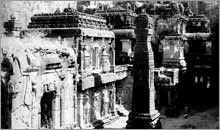Visual Truths
 The relationship between vision and evidence remains an important aspect of archaeological knowledge, and has been articulated as such for over one hundred and fifty years. The complaint of James Burgess, then former Director General of the Archaeological Survey (1885–1889), to John Marshall, the new Director General (1902–1928), about the photographs that were printed in the Annual Report of the United Province and Punjab (Part I) 1904–05, presents one example. Burgess, who held the view that “illustrations alone will be regarded as some additions to our knowledge of Indian art” (1876, p. x) bemoaned that:
The relationship between vision and evidence remains an important aspect of archaeological knowledge, and has been articulated as such for over one hundred and fifty years. The complaint of James Burgess, then former Director General of the Archaeological Survey (1885–1889), to John Marshall, the new Director General (1902–1928), about the photographs that were printed in the Annual Report of the United Province and Punjab (Part I) 1904–05, presents one example. Burgess, who held the view that “illustrations alone will be regarded as some additions to our knowledge of Indian art” (1876, p. x) bemoaned that:
“Evidently the man who takes such views and thinks them worth printing has to learn the first elements of architectural photography. Could he not get a single lesson from Cousens or someone who knows how to use a camera? ... There are buildings––plenty of them––whose walls slope on inwards, and the publication of these photographs may mislead people to think these sculptures also have the same feature” (D.O. letter, 26 January 1905, File 54, Serial No. 1–15/1905, ASI Archives. The reference is to Henry Cousens, see below).
